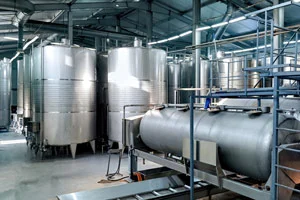Wine refining
From the vineyard to the moment of bottling, the work carried out on the grapes has an impact on the character of the wine produced.
The fine-tuning is the profiling of these aspects and can make you get out of the desired objective. This is where we have to polish the less pleasant sensations and enhance those aspects that we want to be perceived with more intensity, bringing the wine closer to a specific profile.
At Agrovin we seek precision in wine refining.
Balanced wines that have the perfect balance between tactile and aromatic sensations, and to achieve this, we have tools and oenological products developed by our R+D+i department that serve as a guide and facilitate the processes for winemakers.

Determining wine's character
Nowadays it is necessary to know the tastes of the consumer we are targeting even before harvesting the grapes.
This prior knowledge of the wine’s profile will allow us to direct the fine-tuning towards the consumer’s demands and make a great wine, balancing tactile and aromatic sensations.
Balance between tactile and aromatic sensations
In wine, aromatic and tactile sensations are the fundamental pillars of the taste experience, and there must be a balance that allows the two phases to unite and enhance each other to form a great wine, since the aromatic profile not only participates in the olfactory phase but also has great relevance in the taste phase.
At Agrovin, we have developed a common tasting language that allows us to define the wine profile in an easy and schematic way, and we have materialized it in a tool that facilitates decision making when defining the wine’s character and being more precise in wine refining.
Profiling with the SPIRIT range
The treatments carried out in this aspect require precision and knowledge of the base and the intrinsic properties of the tools to be used in each case. The oak alternatives are capable of modulating the taste sensation of the wine without modifying its matrix, and it is under this philosophy that the SPIRIT range of alternatives has been developed, profiling the wines from different tasting aspects and objectives sought, knowing perfectly the characteristics of each one and with the need to work from the knowledge and differentiation of each wine.
When working with alternatives it is important to know the target but also the time available. The SPIRIT range of alternatives is mainly based on two very different formats with which we will obtain a very different extraction and integration in time: chips and topping.
The production of the topping of the SPIRIT range is particularly careful to obtain a very homogeneous product that, due to its pellet structure, has a high contact surface, with very short extraction and harmonization times. In addition, the advantage of these refining alternatives is the effect they have on the wine at a tactile level, improving in each case different aspects of the wine: sweetness, smoothness or persistence.
On the other hand, the range of SPIRIT chips is specifically selected to adapt to all types of wines, but with very different results. Despite requiring longer harmonization and integration times in the wine, the wines infused with these chips are pleasant, without harshness and without dominating the wine base.
Oak, micro-oxygenation and RedOx: The perfect triplet
A strategy applied to facilitate the integration of the alternatives is the combined treatment with O2 supply. Once the alcoholic and malolactic fermentations have been completed, the oxygen supply must be appropriate to the type of wine, so as to improve the integration of the aromatic compounds and tannins yielded by the oak, without entailing a risk of oxidation.

Oak, micro-oxygenation and RedOx: the perfect triplet
At this point, the knowledge of the oxidation-reduction state of the wine, through the monitoring of the electrochemical potential, is essential to make the supply at a dose adjusted to the needs of the wine. The ELECTROWINE – DOSIOX equipment combines both technologies allowing controlled and safe micro-oxygenation according to the effect that O2 is having on the oxidation-reduction state of the wine.
Refining tannins, the final point
The treatments carried out in this aspect require precision and knowledge of the base and the intrinsic properties of the tools to be used in each case. The oak alternatives are capable of modulating the taste sensation of the wine without modifying its matrix, and it is under this philosophy that the SPIRIT range of alternatives has been developed, profiling the wines from different tasting aspects and objectives sought, knowing perfectly the characteristics of each one and with the need to work from the knowledge and differentiation of each wine.
Enhancing fruit and providing structure with Tanicol RED VINTAGE
A strategy applied to facilitate the integration of the alternatives is the combined treatment with O2 supply. Once the alcoholic and malolactic fermentations have been completed, the oxygen supply must be appropriate to the type of wine, so as to improve the integration of the aromatic compounds and tannins yielded by the oak, without entailing a risk of oxidation.

- To enhance varietal aromas.
- Decrease or soften reduction aromas.
- To provide structure without affecting the astringency of the wine.
- Adding complexity by increasing the black and red fruit characters.
- Due to its purity and ease of application, it can be applied to finished wine weeks prior to bottling.

